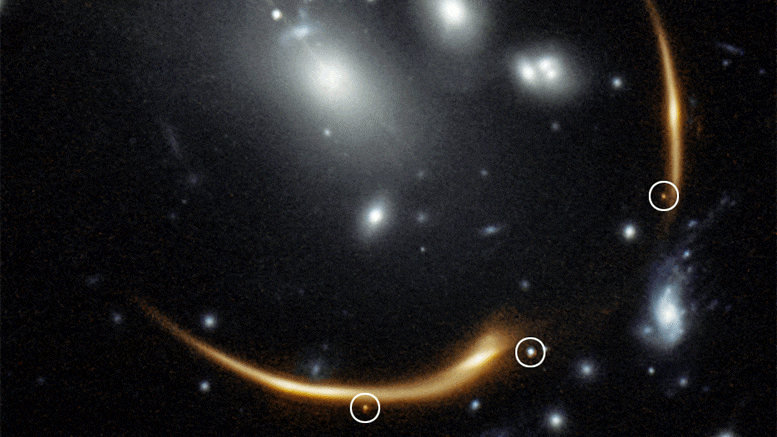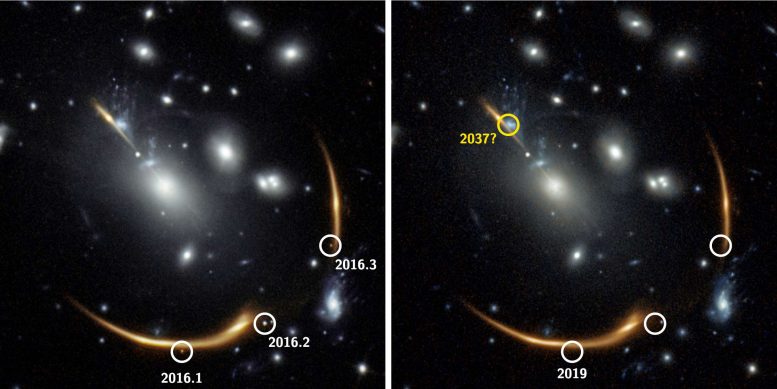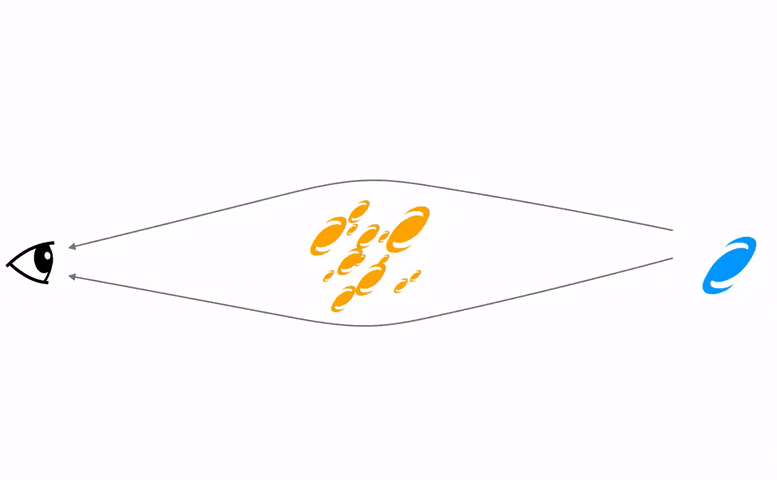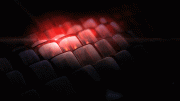
An enormous amount of gravity from a cluster of distant galaxies causes space to curve so much that light from them is bent and emanated our way from numerous directions. This “gravitational lensing” effect has allowed University of Copenhagen astronomers to observe the same exploding star in three different places in the heavens. They predict that a fourth image of the same explosion will appear in the sky by 2037. The study, which has recently been published in the journal Nature Astronomy, provides a unique opportunity to explore not just the supernova itself, but the expansion of our universe.
One of the most fascinating aspects of Einstein’s famed theory of relativity is that gravity is no longer described as a force, but as a “curvature” of space itself. The curvature of space caused by heavy objects does not just cause planets to spin around stars, but can also bend the orbit of light beams.
The heaviest of all structures in the universe — galaxy clusters made up of hundreds or thousands of galaxies — can bend light from distant galaxies behind them so much that they appear to be in a completely different place than they actually are.
But that’s not it: light can take several paths around a galaxy cluster, making it possible for us to get lucky and make two or more sightings of the same galaxy in different places in the sky using a powerful telescope.

Gravity from the MACS J0138 galaxy cluster curves space so much that light from a galaxy behind it is bent down towards us in several different ways. To the left is a picture of the cluster from 2016 in which light from the same exploding star – a supernova – is seen in three places in the night sky. To the right, is the same area in 2019, where the supernova is now gone. Astronomers from the Niels Bohr Institute have calculated that it will reappear in 2037. Credit: S. Rodney (U. of S. Carolina), G. Brammer (Cosmic Dawn Center), J. DePasquale (STScI), P. Laursen (Cosmic Dawn Center))
Supernova déjà-vu
Some routes around a galaxy cluster are longer than others, and therefore take more time. The slower the route, the stronger the gravity; yet another astonishing consequence of relativity. This staggers the amount of time needed for light to reach us, and thereby the different images that we see.
This wondrous effect has allowed a team of astronomers at the Cosmic Dawn Center — a basic research center run by the Niels Bohr Institute at the University of Copenhagen and DTU Space at the Technical University of Denmark — along with their international partners, to observe a single galaxy in no less than four different places in the sky.
The observations were made using the infrared wavelength range of the Hubble Space Telescope.

The light of a galaxy with an exploding star takes different paths around an intermediate galaxy cluster before it reaches us. Astronomers from the Cosmic Dawn Center, among others, have calculated that one route is about 21 light-years longer than the other. As such, they predict that come 2037, we should be able to spot the supernova yet again. Credit: Peter Laursen, Cosmic Dawn Center)
By analyzing the Hubble data, researchers noted three bright light sources in a background galaxy that were evident in a previous set of observations from 2016, which disappeared when Hubble revisited the area in 2019. These three sources turned out to be several images of a single star whose life ended in a colossal explosion known as a supernova.
“A single star exploded 10 billion years ago, long before our own sun was formed. The flash of light from that explosion has just reached us,” explains Associate Professor Gabriel Brammer of the Cosmic Dawn Center, who led the study with Professor Steven Rodney of the University of South Carolina.
The supernova, nicknamed “SN-Requiem,” can be seen in three of the four “mirrored images” of the galaxy. Each image presents a different view of the explosive supernova’s development. In the final two images, it has not yet exploded. But, by examining how galaxies are distributed within the galaxy cluster and how these images are distorted by curved space, it is actually possible to calculate how “delayed” these images are.
This has allowed astronomers to make a remarkable prediction:
“The fourth image of the galaxy is roughly 21 years behind, which should allow us to see the supernova explode one more time, sometime around 2037,” explains Gabriel Brammer.
Can teach us more about the universe
Should we get to witness the SN-Requiem explosion again in 2037, it will not only confirm our understanding of gravity, but also help to shed light on another cosmological riddle that has emerged in the last few years, namely the expansion of our universe.
We know that the universe is expanding, and that different methods allow us to measure by how fast. The problem is that the various measurement methods do not all produce the same result, even when measurement uncertainties are taken into account. Could our observational techniques be flawed, or — more interestingly — will we need to revise our understanding of fundamental physics and cosmology?
“Understanding the structure of the universe is going to be a top priority for the main earth-based observatories and international space organizations over the next decade. Studies planned for the future will cover much of the sky and are expected to reveal dozens or even hundreds of rare gravitational lenses with supernovae like SN Requiem,” Brammer elaborates:
“Accurate measurements of delays from such sources provide unique and reliable determinations of cosmic expansion and can even help reveal the properties of dark matter and dark energy.”
Dark matter and dark energy are the mysterious matter believed to make up 95% of our universe, whereas we can only see 5%. The perspectives of gravitational lenses are promising!
For more on this research, read Supernova Requiem: Rerun of Massive Blast From Exploding Star Expected To Appear in 2037.
Reference: “A gravitationally lensed supernova with an observable two-decade time delay” by Steven A. Rodney, Gabriel B. Brammer, Justin D. R. Pierel, Johan Richard, Sune Toft, Kyle F. O’Connor, Mohammad Akhshik and Katherine E. Whitaker, 13 September 2021, Nature Astronomy.
DOI: 10.1038/s41550-021-01450-9









Be the first to comment on "Supernova Déjà-Vu: Astronomers Spot the Same Stellar Explosion Three Times – And Predict a Fourth Sighting in 16 Years"